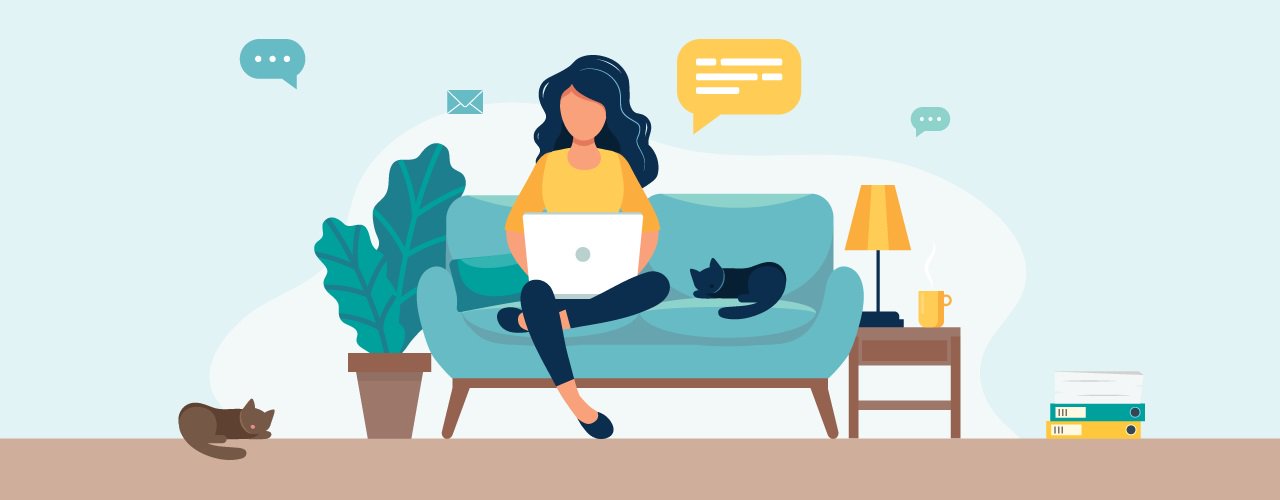When 2020 began, no one could have imagined how it would turn out. Specifically, the pandemic forced many of us to face situations that we would normally not even think about, such as working from home and social distancing — not only among colleagues, but also in daily activities.
So, to learn more about the consequences of these actions, we spoke with several industry experts about the psychological and sociological effects that working from home has had on employees. Read on to find out more.
Meet our Experts

Karen Condor
Human Resources and Insurance Expert with US Insurance Agents

Madina Estephan
Medical Doctor & Expert in Public Health.

Daniel Foley
SEO Specialist at Daniel Foley

Alexis Haselberger
Productivity, Time Management and Leadership Coach Alexis Haselberger Coaching and Consulting

Andrei Kurtuy
Co-Founder and CCO at Novo Resume

Kelly Harris Perin
Founder of Little Bites Coaching

Ryan Scribner
Co-Owner of the Personal Finance Blog Investing Simple

Joe Wilson
Senior Career Advisor at Mint Resume

Dr. Brian Wind
Chief Clinical Officer at JourneyPure
In your opinion, what is the sociological effect of this working-from-home period? What do people miss about office life?
Karen Condor
“On the plus side, workers have found they can be more productive by not having the stress of a commute, by not dealing with the disruptions of a typical office environment, and by customizing both their home office environment, as well as their work schedule.
On the minus side, the lack of in-person, human connection can lead to isolation and stress caused by the decrease in communication and engagement. Also, a blurring between work and home can increase stress for workers who have trouble disconnecting and feel they are on-call around the clock.”
Madina Estephan
“Working from home became a recognized ‘gold standard’ of the new organizational reality. However, the question of how to find a balanced hybrid model fitting to each organization remains open. Several studies evaluated the impact of working from home on people.
Interestingly, Tech and Millennial generations were not so happy with working from home; they were missing after-work interactions and community sense. While managers were satisfied by teamwork, in general, members of teams were expecting more direct one-to-one management, missing clear processes and framed rules. Another common trend is increased working hours, [as well as] difficulties to maintain borders between private and working space; general feeling of anxiety; and stress while working from home during lockdown.
Another research conducted from September 2019 to October 2020 questioned 87,547 employees on the topic of working from home. The happiness index was rather high in 68% of people. The motivation was at its peak at the beginning.
Another interesting fact was a strong correlation between quality of work-from-home experiences and motivation. Those employees who had positive work-from-home experiences in the past were more effective and open to continue working from home.”
Daniel Foley
“People are going to have difficulty adjusting to not having everything at a moment’s reach. Whether that be asking a colleague a question or [an] information file kept in the back office. Working from home takes some adjustment, and especially for companies who weren’t already taking advantage of online and clouds for filing, this could prove to be a difficult transition that takes some getting used to.”
Alexis Haselberger
“The thing that comes up over and over is that people miss the spontaneous nature of office life. People miss running into someone in the hallway or the kitchen and having a conversation. People miss overhearing conversations. People miss being able to stop by someone’s desk for a quick chat. Every conversation is now scheduled and not only does that feel stifling, [but] people are working longer hours because of it.”
Andrei Kurtuy
“Our workers have expressed a lot of loneliness and feelings of isolation from other adults and regular life, whatever that might mean. There’s been a collective grieving process going on as employees were accustomed to being physically close and emotionally tight knit, but now everything is disjointed and feels overly formal. People only interact when there’s a meeting. There’s no chatting over lunch like there used to be. People are finding ways to feel more connected, but it can’t replace what was lost.”
Kelly Harris Perin
“Some trends I’ve noticed as a result of the pandemic:
My clients who have a ‘best friend at work’ (that phrase is taken from Gallup’s Q12 employee engagement survey) have been leaning on their closest work friends, in many cases texting or Zooming several times per day as they navigate the reality of working from home during a pandemic. Unfortunately, what researchers call ‘weak ties’ have suffered. Those are the collegial relationships with people you may see in meetings or chat with over lunch at the office, but don’t work with closely. In other words, if you didn’t have someone’s number in your phone in March, you’re not likely to have added it over the last few months. Fewer ‘weak tie’ connections can mean that individuals are less engaged overall AND that the fabric of the organization is less strong. Leaders need to focus on new ways to make and strengthen connections throughout their teams.”
Ryan Scribner
“The impact of the work-from-home movement is just an acceleration of a trend that we have been seeing for years. This is, of course, the trend of humans becoming far less social and more independent. One thing that Zoom and other work-from-home solutions cannot provide is the collaborative work environment of the office. People are not as amped about sitting on a laptop at home versus being in a meeting sharing ideas.”
Joe Wilson
“Sociologically, there have been some impacts in terms of people being isolated. Sure, there are Zoom calls, etc., but it does not have the effect of face-to-face meetings. We are largely in isolation and desperate for some social interaction. Little things, like meeting a colleague in the hallway, making a cuppa together, etc. The lack of these things can be felt.”
Dr. Brian Wind
“One impact of working from home is the reduction in social interaction and collaboration. It’s not as easy to engage in casual conversation while working from home, and it’s harder to get quick updates on what everyone else is working on. Face-to-face social interactions are more formalized, and people may only be having them during formal video conferences.”
In the future, when we will be working both in the office and at home, how many days should we work at the office in order to keep a healthy balance between the two? What are the advantages/disadvantages of one or the other?
Karen Condor
“That depends on the type of work, as more days would be needed if the work demands a high amount of collaboration. It also depends on the worker’s needs, as less days would be needed the less a worker craves in-person interaction in order to reduce stress.
If working in the office is too emphasized, employees may become resentful having to commute and transfer work from home if they think it’s unnecessary. If working from home is too emphasized, employees may suffer from missing teamwork which creates a sense of inclusiveness, gives everyone a chance to speak up, and keeps everyone on the same page.”
Madina Estephan
“There is no one recipe for everyone. Rather, each organization has to create their own unique, bold and flexible solutions. First of all, the wise approach would be to have the right understanding/diagnosis of the particular organizational needs — those of teams and individual employees, [plus] step-by-step implementation process and transparent communication. I would rather make employees proactive participants in designing new work-from-home environments. Like for effective communication, each organization has to find the optimal risk/benefit balance, keeping in mind three effectiveness growth opportunities.
- Increased involvement/effectiveness of each employee and belonging to common goals.
- Sustainable synergies between teams and within teams.
- Protection and prevention of the mental and physical health of everyone within the organization.”
Daniel Foley
“I think two days in office would be a good experiment to see how things worked, preferably at the start of the week. I think this could allow for one day for meetings, catch-ups and planning, while the second day would allow for doing, preparing and asking any follow-ups before finishing the week remotely.”
Alexis Haselberger
“I think this is going be to really dependent on individuals and what they want; it’s not a one-size-fits all situation. However, I think that, ideally, people are going to want to be in the office between one and three days a week. I think very few people are going to want to be in the office every single day because, once out of COVID and kids are back in school, working from home should return to a state where it’s easier to get head’s down work done.
If we were to go all remote, we lose that spontaneity and the creativity that comes with it. If we go all in back to the office, I think morale will decrease because there’s so much value to simply not having a commute every single day, and getting a few days a week of peace and quiet to get some real work done.”
Andrei Kurtuy
“I’d say the right mix of working from home and working in the office is going to vary depending on your job and personality. However, an average employee needs two to three days in the office every week in order to maintain the flow of the business process.
Spending too much time in the office exposes employees to greater health risks and should be avoided until vaccine distribution can support herd immunity. However, spending too much time working from home makes employees feel out of touch and disconnected from their job functions. It can be hard to get into the groove to work when you’re left to your own devices so much of the time.”
Ryan Scribner
“For most people, a minimum of two days in the office makes sense. I think spending around half of your time working independently from home will boost productivity, while giving you enough time in the office to facilitate a collaborative environment. Too much time in the office could lead to unwanted distractions and water cooler conversations. Not enough time could lead to depression and a lack of feeling connected to the greater goal.”
Joe Wilson
“Working from home has huge benefits, and the flexibility has given a better life balance. When things return to normal, a 50/50 split would be a good balance, but this will need to fit with the organization and types of services sold. It’s important to look at the reasons for the split, rather than just demanding everyone does the same. There needs to be logic to make workers feel happy and valued.”
Dr. Brian Wind
“Working two or three days in the office will maintain a healthy balance. Working in the office too often can result in more time spent on the commute, which can be physically and mentally draining, while leaving less time and energy for leisure activities or family time. It can also be more challenging for parents and caretakers to juggle the demands of office work and home.
On the other hand, working from home too much can result in social isolation since casual collaboration and conversation doesn’t take place as easily online. It can also cause employees to feel more disconnected from other employees and the overall company culture.”
What do you think about working from home in relation to creativity? Does it help employees be more creative or make them more exhausted?
Karen Condor
“Working from home can increase creativity as workers can thrive within a self-created structure. They can adapt their environment to how they work best, such as if they think better with music or with silence. They can also adapt their work time, such as if they are more productive first thing in the morning or in the evening. And, they can manage their interruptions, cultivating space for creative time.”
Madina Estephan
“The creative capacity of providing added value of each employee is at the peak when his passion and motivation are ‘shaking hands.’ In a stressful environment, internal resources of each individual are limited to survival. By creating healthy work-from-home environments, organizations will boost them to translate talents to creative actions.”
Daniel Foley
“Creativity can thrive in any environment. What is important is making sure that you are using the best tools to keep teams engaged when they are separate. Consider how often you digitally meet over Zoom and what project management apps and tools you are using.”
Alexis Haselberger
“There is definitely creative value to people being in a room and bouncing ideas off each other, but there’s also a lot of evidence to suggest that we get better and more diverse ideas if people brainstorm alone, and then bring their ideas together. So, I think we can get the best of both worlds. Let people start getting the creative juices flowing alone, then come together to riff.”
Andrei Kurtuy
“Employees who seek out stimulating ideas and use the downtime during the pandemic to research their personal and professional interests are seeing increased creativity. However, workers who are less self-directed or who have more family obligations aren’t able to take such advantage of the extra time. For them, the downtime can be exhausting.”
Ryan Scribner
“The work-from-home movement is a mixed bag when it comes to creativity. Some people are more creative when they think quietly about things themselves, while others need to bounce ideas off of each other. So, it largely depends on what type of personality you have.”
Joe Wilson
“Creativity when working from home can be difficult without someone to bounce ideas off of. This is a huge part of a creative process. However, on the flip side, home working can be quieter and easier to concentrate, and you can factor in things that help with the creative process, such as a walk or some yoga.”
Dr. Brian Wind
“Working from home can mean more distractions, but it also makes it easier to block out messages and emails when you want to focus. However, creativity that comes from collaboration and social conversation by building on each other’s ideas may decrease.
Not only does virtual and distanced working risk loneliness, [but] it is also bound to reduce on-the-job learning, creativity and innovation — all of which are often tied to serendipitous encounters.”
If you found this article useful and informative, please feel free to check out our Expert Insights & Roundup Series.



